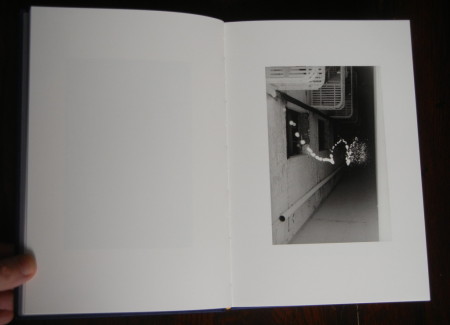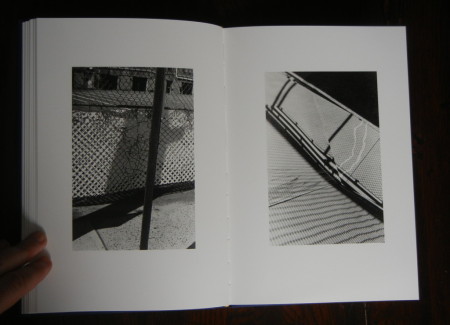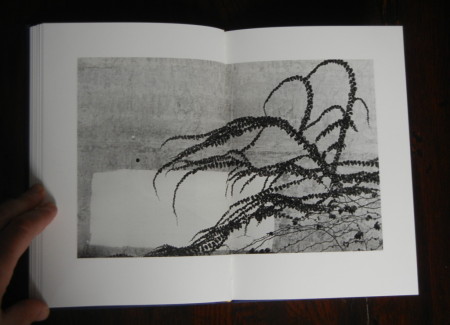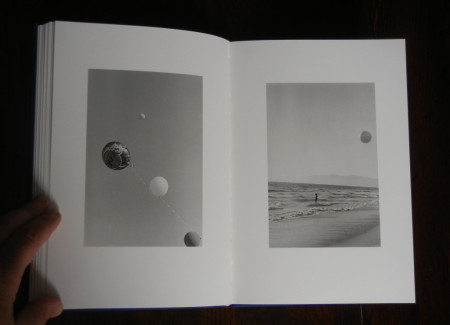JTF (just the facts): Published in 2014 by Trolley Books (here). Hardcover, 96 pages, with 64 black and white photographs. There are no texts or essays included. (Spread shots below.)
Comments/Context: If there is one consistent failure mode in today’s conceptual photography, it is the tendency for the work to become too self-consciously serious. When images go too far in their efforts to impress us with their obtuse braininess, all the life is drained out, leaving us with flat pictures that are full of arcane academic rigor but that fail to move us. Back in the 1970s, pioneers of photoconceptualism like Baldessari, Cumming, Wegman, and others deftly avoided this hermetically sealed trap by introducing an element of wry visual humor into their work. They brought playfulness to the party, cleverly exploring the limits of camera-based seeing via optical tricks and carefully staged set-ups, injecting lively energy into often cerebral experiments in perspective and scale.
While British photographer Robin Maddock’s new book isn’t a formal conceptual exercise exactly, the project certainly shares the gleeful spirit of the early photoconceptualists. Using the sun blasted streets of California as his stage, Maddock has introduced three unlikely props: a ping pong ball, a sheet of paper, and various amounts of milk, each an unexpected flash of white in an otherwise ordinary scene. These three objects (and their shadows) offer him a surprisingly wide variety of visual options to juxtapose with the surroundings. He has round (the ping pong ball), rectangular (the paper), and fluid form fitting (the milk) physical shapes, and motions that include floating and bouncing (the ping pong ball), drifting and blowing (the paper), and dripping, puddling, and pouring (the milk).
Maddock creates a kind of magic with these choices, mixing blinding white and deep Metzker-like black in high contrast compositions that feel quirky and light. The ping pong ball has the most jaunty personality, soaring toward a basketball hoop, sizing itself up with balloons, bounding down the sidewalk, and jumping in the swimming pool, its twin black circle shadow never far behind. Not surprisingly, the milk is more of a shape shifter, filling up loafers and a paper lunch bag, falling down an airshaft, and oozing along an arrow straight crack in the sidewalk. The paper is at the mercy of the unseen wind, getting caught in the keys of a decaying piano, tagging along on a pedestrian’s shoe, and flattening itself against plate glass windows and mirrors. Each scene feels playfully interrupted, the prop recalibrating our experience of the setting. In a few of the images, Maddock’s shadow intrudes with a Friedlander-ish lean, adding a dark silhouette to his selection of visual motifs.
The reason this doesn’t devolve into a Where’s Waldo, find the ping pong ball cuteness is that Maddock’s sense for contrast and composition is finely honed, especially when it comes to shadow play and whitewashed brightness. Both the ping pong ball and a dangling pay phone handset create doubled shadows in one image, the white of the sidewalk and the black of underneath zone creating a gloriously angled, almost noir feel; the ominously floating ball in the dark library stacks has a similar sense of don’t walk around the corner foreboding. Maddock does eventually give us a seemingly dead body (with a smart dark black pool of blood to contrast with other white milk puddles we’ve seen), but we’re quickly brought back to more formal concerns, where sidewalks, door frames, chain link fences, and light poles create geometries of white and black for the objects to play with. It’s hard not to smile just a little when the ball jumps over the estate sale box or the milk pours over a statue like bird droppings.
I wish more contemporary photography had the knowing humor of Maddock’s small project. But don’t let that impishness distract you from the controlled complexity Maddock has created; underneath that frisky exterior are a group of consistently quick-witted and well-crafted photographs that will have much more durability than their whimsical flavor might predict.
Collector’s POV: Robin Maddock is represented by TJ Boulting in London (here). His work has little secondary market history, so gallery retail remains the best option for those collectors interested in following up.





















A very well observed review of a clever and funny book. Maddock’s two previous books were in a completely different, that is, photo-journalistic, style. In particular ‘Our kids are going to hell’ is excellent and was noted as such in the recent Parr Badger vol III. Anyway he seems a talented fellow and one to watch out for.